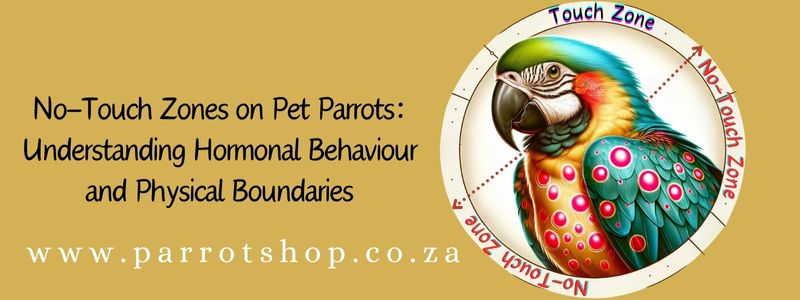No-Touch Zones on Pet Parrots: Understanding Hormonal Behaviour and Physical Boundaries
Abstract:
This article delves into the concept of the "no-touch zones" on pet parrots, shedding light on specific areas of a parrot's body that, when touched, can trigger hormonal behaviour. Drawing from scientific research and expert insights, we explore the significance of establishing boundaries and promoting a parrot's overall well-being.
Introduction:
Pet parrots are known for their affectionate nature, but it's important to understand that their physiology and behaviours differ from those of humans. While some parrots may enjoy physical affection, many can become hormonally stimulated when specific areas of their bodies are touched. This article aims to educate parrot owners about these sensitive areas, based on scientific studies and expert recommendations.
The No-Touch Zones: Avoiding Hormonal Triggers
Parrots, like other birds, have specialized areas on their bodies that, when stimulated, can trigger hormonal behaviours. These behaviours are often associated with mating and can include increased vocalisation, territorial aggression, and even attempts at mating with their humans. To maintain a healthy and well-adjusted parrot, it's crucial to be aware of and respect these boundaries.
Sensitive Areas Identified by Research:
-
Nape and Back: Studies by Mulder and Marler (1990) have shown that touching the nape and back of parrots can simulate the mating process, leading to hormonal surges. Avoid stroking or petting these areas.
-
Under the Wings: Research conducted by Pepperberg (1999) on African Grey Parrots revealed that touching or tickling under the wings can provoke mating behaviours. Be cautious when handling this area.
-
Lower Back and Tail Area: The lower back and tail are particularly sensitive areas. A study by Arlet et al. (2009) found that stimulation in this region can lead to territorial aggression and increased hormonal activity.
Promoting a Parrot's Well-Being:
Understanding the no-touch zone is essential for responsible parrot ownership. It's vital to establish boundaries while still providing love and care to your feathered companion. Engaging in non-physical forms of interaction, such as talking, playing, and providing mental stimulation, can help fulfil your parrot's social and emotional needs.
References:
-
Mulder, R. A., & Marler, P. (1990). Sexual selection and the elaboration of vocal signals in birds. In P. Marler & H. Slabbekoorn (Eds.), Nature's Music: The Science of Birdsong (pp. 319-338). Elsevier.
-
Pepperberg, I. M. (1999). The Alex Studies: Cognitive and Communicative Abilities of Grey Parrots. Harvard University Press.
-
Arlet, M. E., Odell, D. K., & Schmidt, K. A. (2009). Domestic pigeons (Columba livia) generate a constitutive immune response to testosterone, but not to its boreal counterpart, 17β‐estradiol. Functional Ecology, 23(2), 347-354.

